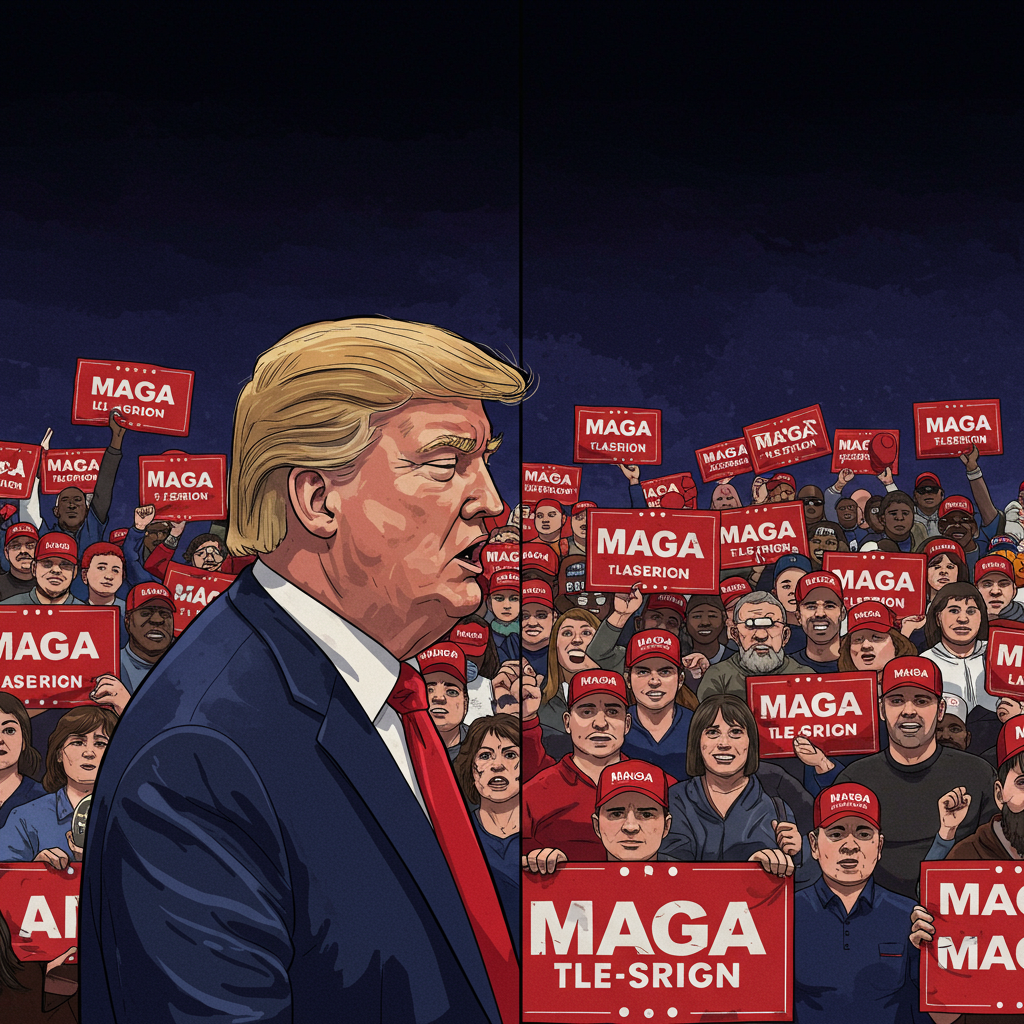A critical legislative confrontation has gripped Washington D.C. as house Speaker Mike Johnson grapples with the immense challenge of unifying his sharply divided republican caucus. The objective: push through a complex, far-reaching bill packed with significant tax policy revisions, including extending Trump-era cuts, alongside contentious spending reductions and new immigration measures. Despite intense pressure from former President Donald Trump and GOP leadership aiming for swift passage, the process initially stalled. This delay exposed deep rifts within the party and raised serious questions about the bill’s viability and Speaker Johnson’s capacity to lead. The outcome of this high-stakes battle carries major implications for economic policy, government finances, and the Republican party’s standing heading into upcoming elections.
Inside the Ambitious GOP Legislative Package
Dubbed the “One Big Beautiful Bill” by former President Trump, this proposed legislation is an expansive attempt to consolidate key Republican priorities into a single package. At its heart lie broad tax provisions designed to reshape the fiscal landscape. The bill aims to extend and make permanent various individual and business tax cuts first enacted during President Trump’s initial term in office. It also seeks to introduce new tax benefits championed during his recent campaign, such as eliminating federal income taxes on tips and overtime pay. A specific $6,000 deduction for older adults earning below $75,000 annually is also included. Recent amendments added in the House specifically raised the cap on State and Local Tax (SALT) deductions to $40,000 for households earning up to $500,000, a concession aimed at winning over skeptical members. Additional tax breaks for auto loans were also incorporated.
Beyond individual benefits, the bill targets business taxation. It proposes restoring several key business tax incentives initially passed in 2017. These include allowing companies to fully expense research and development (R&D) costs immediately and providing bonus depreciation for capital investments. Restoring the deductibility of business interest expenses is another core component. Supporters contend these measures are vital for stimulating economic growth and bolstering American business competitiveness globally.
However, the legislation extends well beyond tax cuts. It mandates significant spending reductions across various sectors. Social safety net programs like medicaid and the Supplemental Nutrition Assistance Program (SNAP, or food stamps) face substantial cuts. Republican proponents argue these cuts are necessary to “right-size” programs, better focus benefits, and combat waste, fraud, or abuse, partly through new or accelerated work requirements. While initially set for 2029, the proposed start date for Medicaid work requirements was reportedly moved up to the end of 2026 in an effort to satisfy hardline conservatives. The bill also allocates substantial funding for defense and President Trump’s immigration initiatives, including enhanced border security measures and resources for deportation operations. It also includes provisions for state border security reimbursements. Further spending impacts include accelerating the phase-out of certain clean energy tax credits enacted under the current administration and requiring new renewable energy projects to meet strict construction and operational deadlines. While leadership touts potential spending “savings,” estimates on the bill’s overall impact on the national debt vary significantly among analyses, ranging from roughly $2.3 trillion to over $5 trillion added over the next decade, primarily driven by the scale of the proposed tax cuts.
Internal GOP Fault Lines Halt Progress (Initially)
Securing the votes needed to pass this comprehensive “megabill” has proven exceedingly difficult for Speaker Johnson, especially given the Republican party’s razor-thin 220-212 House majority, allowing for the loss of only three Republican votes. Opposition has emanated from distinct factions within his own party.
One bloc consists of hardline fiscal conservatives, many affiliated with the House Freedom Caucus. Their primary concern remains the national debt and the bill’s projected negative impact on the deficit, particularly in the short term. Members like Reps. Chip Roy (R-TX), Andy Harris (R-MD), and Ralph Norman (R-SC) argue the bill lacks fundamental structural spending reforms and doesn’t implement deep enough cuts. They are critical of aspects such as the expansion of the refundable child tax credit, viewing it sometimes as welfare spending that might disincentivize work. Some desired even deeper cuts to programs like Medicaid or the elimination of subsidies from the Inflation Reduction Act.
Conversely, moderate Republicans, often representing competitive districts or high-tax states such as New York and California, voiced different concerns. Their worries centered more on the proposed cuts to Medicaid and SNAP, fearing detrimental consequences for vulnerable constituents. These members also strongly advocated for relief from the $10,000 cap on the deduction for State and Local Taxes (SALT), which was implemented under the 2017 tax law. Rep. Mike Lawler (R-NY) was a prominent voice pushing to lift this cap, asserting its necessity for his constituents despite previous resistance from former President Trump.
The sheer breadth of the bill meant different provisions were objectionable to different members, creating a formidable challenge for finding consensus. While some fiscal conservatives initially stalled the bill over the perceived inadequacy of spending cuts, concessions like accelerating Medicaid work requirements only heightened concerns among moderates apprehensive about potential health coverage losses for their constituents. This internal conflict was vividly displayed during procedural votes, including one that reportedly lasted for an unusually long seven hours, highlighting the deep ideological chasm within the party.
Trump’s Relentless Pressure Campaign
Former President Trump has positioned himself as a pivotal figure in the drive to pass the bill, actively engaging with House Republicans to sway reluctant members. He hosted lawmakers at the White House, participated in frequent phone calls, and held meetings on Capitol Hill, described by some attendees as a “pep talk.” Trump consistently emphasized the political urgency, warning publicly that delaying passage was detrimental, stating on social media that “MAGA IS NOT HAPPY, AND IT’S COSTING YOU VOTES!!!”
Trump’s approach has been direct and forceful. He has shown a willingness to publicly criticize, and even threaten primary challenges against, Republicans who oppose his agenda, famously targeting Senator Thom Tillis (who later changed his vote) and Rep. Thomas Massie (R-KY), a steadfast opponent of the bill. Described by allies as an “ultimate closer,” Trump leverages his substantial influence within the party to push members into line.
During meetings, Trump was reportedly persuasive, employing humor and direct appeals to urge Republicans to unite and “land the plane.” He stressed the need for party unity despite acknowledged internal divisions. His messaging sometimes sought to counter specific concerns; for example, reports suggest he told members “don’t mess with Medicaid” while simultaneously advocating for the bill which includes significant Medicaid changes, appearing to try and reassure members worried about the optics or impact of these cuts on sympathetic populations. However, while aggressively pushing the tax cuts and other priorities, Trump was reportedly less detailed on how the bill’s significant projected costs would be fully offset or how long some provisions would remain in effect.
Navigating the Narrow Path to House Passage
Speaker Johnson has worked intensely behind the scenes to shepherd the legislation through the House. His strategy involved numerous closed-door meetings, emphasizing the potential economic benefits and framing passage as a political imperative to demonstrate legislative competence ahead of the 2024 elections. Johnson publicly championed the bill as “responsible and impactful,” attempting to bridge the divide between the conservative and moderate wings of the party.
The process was fraught with difficulty. Initial procedural votes highlighted the precarious nature of Johnson’s majority, with Republicans withholding support and causing significant delays, including an unusually long vote held open for frantic last-minute negotiations. The decision to quickly bring the bill to a floor vote, less than 24 hours after it cleared a committee, also sparked contention among members who felt rushed or excluded from the drafting process.
Johnson successfully navigated this delicate balance by making significant concessions. To appease conservative holdouts and secure the necessary votes, changes were made, including accelerating the start date for Medicaid work requirements. To gain moderate support, the cap on SALT deductions was significantly raised to $40,000. Ultimately, after an all-night session and intense pressure, the House narrowly passed the bill by a vote of 215-214, with only two Republicans (Massie and Davidson) joining Democrats in opposition and one (Harris) voting “present.” This narrow victory, however, came at the cost of significant internal friction and required substantial revisions to the bill’s text to bridge the divides.
United Democratic Opposition and Stark Impact Warnings
Democrats remained uniformly opposed to the bill throughout the process. House Democratic Leader Hakeem Jeffries consistently highlighted their united front, noting that the bill’s initial stalling and potential defeat in the House depended entirely on a small number of Republican defections.
Democrats sharply criticized the proposed cuts to social safety net programs, arguing that reductions in Medicaid and SNAP could severely harm vulnerable populations. This includes low-income families, the elderly, and people with disabilities. Critics warned that these cuts could lead to preventable deaths, increased food insecurity, and millions losing health coverage. Estimates on potential health coverage losses cited by Democrats and analyses varied, ranging from over 8 million to as high as 17 million Americans.
Furthermore, Democrats pointed to analysis indicating the bill’s tax cuts would disproportionately benefit wealthier Americans. Compared to what would happen if existing tax cuts expired, analysts suggested that while lower earners might see small average annual tax breaks (around $150), middle-income earners might average around $1,750, and the top 20% could average over $10,000 annually in benefits. While Democrats were involved in an earlier bipartisan framework that included some child tax credit expansion, their concerns about the overall cost, the extent of corporate tax breaks, and the severity of social program cuts meant they would not provide votes to help Johnson pass the bill. Democrats actively targeted Republican incumbents in swing districts with high concentrations of Medicaid enrollees, using the vote as a tool to highlight the potential negative impacts of the cuts and warn incumbents of political consequences in 2026.
The Battleground Shifts: Senate Stall and Remaining Uncertainty
Although the House managed a narrow passage, the legislative battle is far from over. The bill moved to the Senate, where it immediately encountered similar obstacles, including procedural votes that stalled for hours as Republican senators demanded further concessions. The Senate, with its even narrower three-vote Republican majority, also requires near-total party unity for significant legislation.
Specific Republican senators expressed concerns, leading to protracted negotiations. Senator Thom Tillis, initially opposing a procedural motion, reportedly faced threats of a primary challenge from former President Trump before ultimately changing his vote. Other holdouts included Senators Ron Johnson and Rand Paul. Vice President JD Vance reportedly played a key role in late-night negotiations, particularly with fiscal hawks pushing for deeper spending cuts. Senator Lisa Murkowski, a centrist, reportedly secured language easing some requirements before voting yes on a procedural step.
Senate Republican leaders have indicated they plan to revise the House-passed package, signaling that the bill’s final form remains uncertain. While the stated goal is to deliver a final version to President Trump’s desk by the July 4th deadline, the deep divisions evident in both chambers, the need for potential bipartisan support or further internal concessions in the Senate, and the complex nature of the bill mean its future remains very much in doubt. The ongoing struggle underscores the profound political divisions within Congress and the persistent challenges Republican leadership faces in uniting their caucus behind President Trump’s key legislative priorities.
Frequently Asked Questions
What specific tax benefits are included in the passed House GOP bill?
The House-passed bill includes extending most of the 2017 Trump-era individual and business tax cuts. It adds new benefits like eliminating federal taxes on tips and overtime pay, a $6,000 deduction for older adults below a certain income, and importantly, raising the State and Local Tax (SALT) deduction cap to $40,000 for households up to $500,000. It also restores business incentives such as immediate R&D expensing and bonus depreciation.
Why did passing the “big, beautiful bill” face such difficulty in the House GOP, and where does it stand now?
Passage was difficult due to deep divisions within the Republican party’s narrow House majority. Fiscal conservatives worried about the national debt and insufficient spending cuts, while moderates feared cuts to Medicaid/SNAP and pushed for SALT cap relief. Despite these challenges and initial procedural stalls, the bill narrowly passed the House (215-214) after concessions were made. However, it now faces similar hurdles and negotiations in the Senate, where its future and final form remain uncertain.
What are the main criticisms of the bill’s spending cuts, particularly regarding health coverage?
Critics, primarily Democrats and some moderates, argue the significant cuts to programs like Medicaid and SNAP will harm vulnerable populations, including low-income families, the elderly, and those with disabilities. Concerns are high that changes, including accelerated work requirements for Medicaid, could lead to millions losing health insurance coverage, with various estimates suggesting anywhere from over 8 million to 17 million people could be impacted. Democrats also criticize these cuts as funding tax breaks for wealthier Americans.
Conclusion
The legislative journey of this expansive Republican package highlights the profound ideological and tactical divisions fracturing the GOP. Speaker Mike Johnson successfully navigated the House’s internal conflicts, albeit narrowly and after significant concessions, demonstrating his ability to corral his caucus under immense pressure from former President Trump and various factions. However, the battle has merely shifted to the Senate, where similar divisions and procedural challenges have already stalled progress. The struggle to pass this legislation underscores the fragility of the Republican majorities in both chambers and the persistent difficulty in translating broad party goals into unified legislative action. Whether the “One Big Beautiful Bill” can ultimately clear the Senate and reach the President’s desk by the July 4th target remains highly uncertain, but the outcome will undoubtedly shape the Republican party’s legislative agenda, its internal dynamics, and the broader political landscape heading into a pivotal election cycle.




